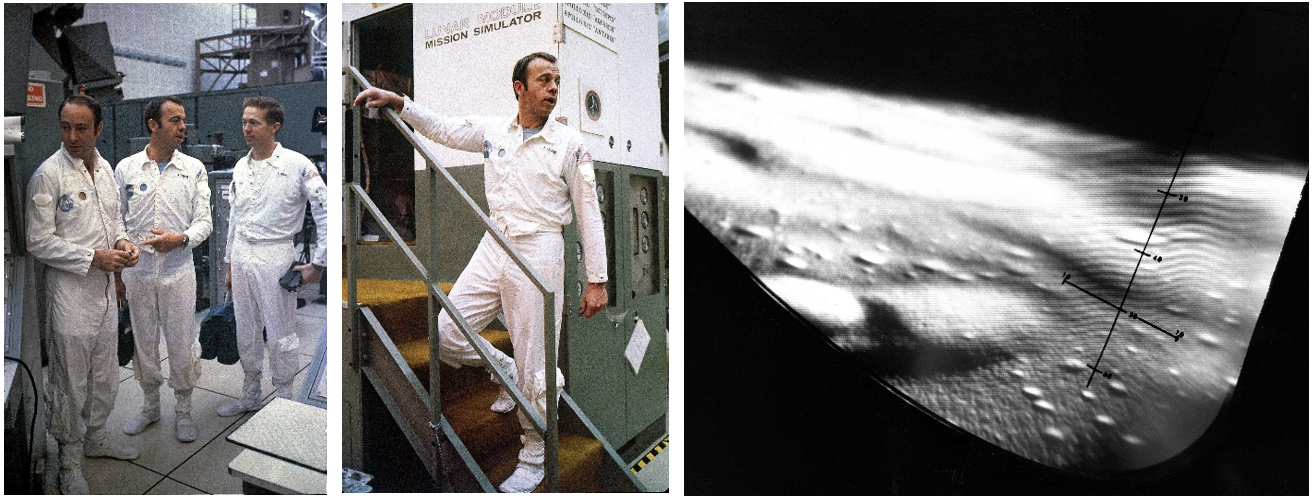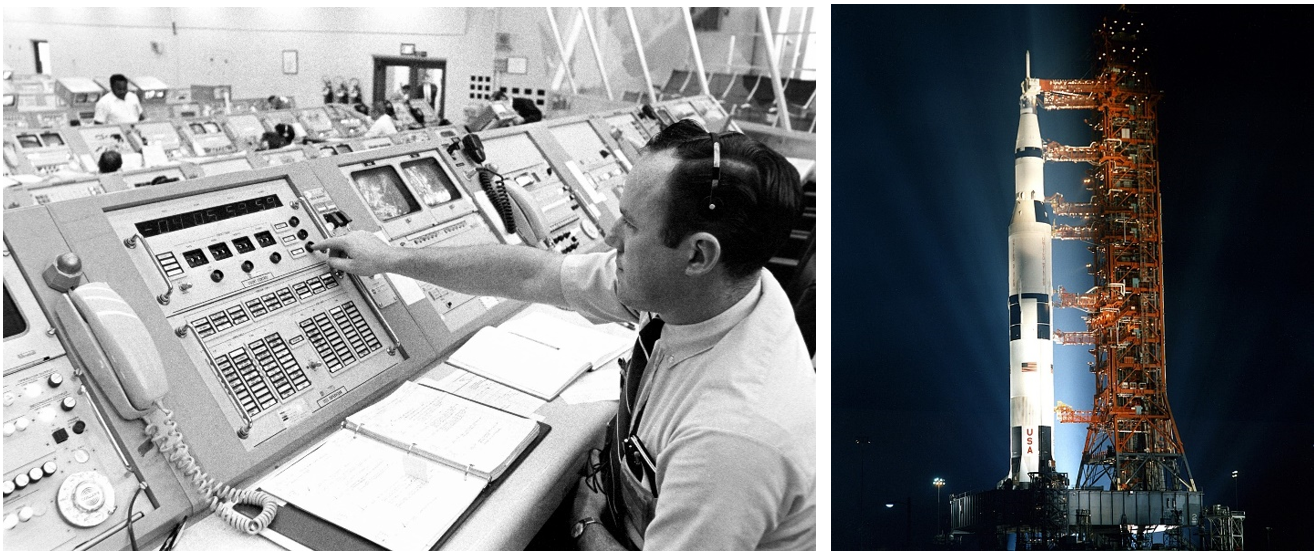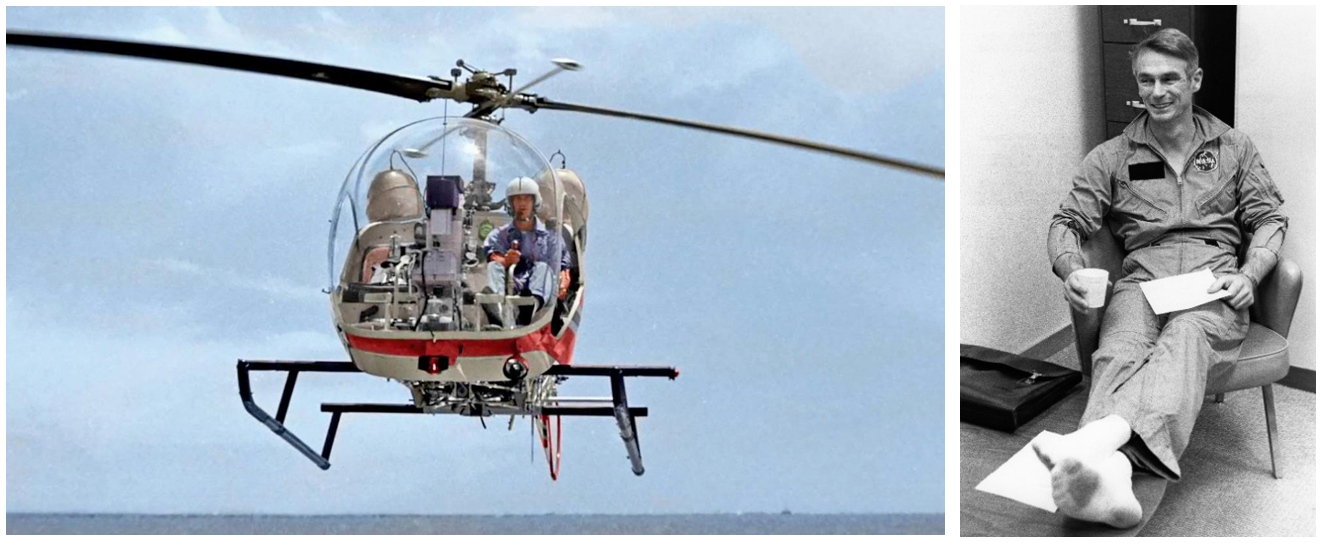Fifty Years Ago: One Week Until Apollo 14
The Apollo 14 crew of Commander Alan B. Shepard, Command Module Pilot Stuart A. Roosa, and Lunar Module Pilot Edgar D. Mitchell spent the last week before their Jan. 31, 1971 launch at NASA’s Kennedy Space Center receiving their final mission briefings, reviewing hardware being stowed aboard their spacecraft, and conducting final runs in spacecraft simulators. In the last days before the launch, the astronauts got in some flying aboard T-38 Talon aircraft. The preliminary countdown for Apollo 14 began as scheduled on Jan. 25, including the initial filling of the Saturn V rocket with propellant. Two separate aircraft accidents, one involving backup Commander Eugene A. Cernan, and another a NASA pilot, occurred the same week. Neither pilot suffered major injuries, and the incidents did not have an impact on the Apollo 14 launch. NASA established investigation boards for both accidents.
 Left: Apollo 14 astronauts Stuart A. Roosa, left, Alan B. Shepard, and Edgar D. Mitchell review documents during the final week before their launch to the Moon. Middle: Roosa, left, Shepard, and Mitchell during the Command Module stowage review. Right: Behind glass during their preflight medical isolation, Roosa, left, Mitchell, and Shepard receive a mission briefing. Credits: NASA
Left: Apollo 14 astronauts Stuart A. Roosa, left, Alan B. Shepard, and Edgar D. Mitchell review documents during the final week before their launch to the Moon. Middle: Roosa, left, Shepard, and Mitchell during the Command Module stowage review. Right: Behind glass during their preflight medical isolation, Roosa, left, Mitchell, and Shepard receive a mission briefing. Credits: NASA
 Left: Mitchell, left, Shepard, and Roosa outside the mission simulators at NASA’s Kennedy Space Center. Middle: Shepard climbs the stairs to enter the Lunar Module simulator. Right: Inside the Lunar Module simulator, the view of the approach to the Fra Mauro landing site. Credits: NASA
Left: Mitchell, left, Shepard, and Roosa outside the mission simulators at NASA’s Kennedy Space Center. Middle: Shepard climbs the stairs to enter the Lunar Module simulator. Right: Inside the Lunar Module simulator, the view of the approach to the Fra Mauro landing site. Credits: NASA
 Apollo 14 astronauts Shepard, left, Roosa, and Mitchell get some flying time in aboard T-38 Talons in the final days before launch. Credits: NASA
Apollo 14 astronauts Shepard, left, Roosa, and Mitchell get some flying time in aboard T-38 Talons in the final days before launch. Credits: NASA
 Left: Charles F. “Chuck” Henschel, chief space vehicle test supervisor, pushes the button to start the countdown clock for Apollo 14. Right: The Apollo 14 Saturn V on Launch Pad 39A the night before launch. Credits: NASA
Left: Charles F. “Chuck” Henschel, chief space vehicle test supervisor, pushes the button to start the countdown clock for Apollo 14. Right: The Apollo 14 Saturn V on Launch Pad 39A the night before launch. Credits: NASA
Apollo astronauts practiced skills required to land on the Moon by flying helicopters. On Jan. 23, 1971, during a training mission from Patrick Air Force Base south of Kennedy, Apollo 14 backup Commander Cernan’s Bell 47G helicopter crashed into the Indian River. Cernan escaped the crash with minor abrasions and contusions, along with a slight singing of his eyebrows and eyelids. Robert R. Gilruth, director of the Manned Spacecraft Center (MSC) in Houston, now NASA’s Johnson Space Center, named a five-member board to investigate the accident, with astronaut James A. Lovell acting as the chair. The board’s findings, released on Oct. 18, 1971, cited Cernan’s inability to judge altitude over the water as the cause of the accident, adding that his experience piloting high-performance aircraft contributed to this, as he was used to terrain passing by much faster than in the slow helicopter. The board cited Cernan’s water-survival training as a pilot and astronaut, with his ability to exit safely from the submerged helicopter after the crash and to avoid the burning fuel on the water, helped prevent the accident from being fatal. The crash notwithstanding, on Aug. 13, 1971, NASA named Cernan as the commander of Apollo 17, the final Moon-landing mission in the program.
 Left: Apollo 14 backup commander Eugene A. Cernan flys a Bell 47G helicopter, similar to the one in which he crashed on Jan. 23, 1971. Right: Cernan relaxes after his helicopter crash, during which he suffered only minor injuries. Credits: NASA
Left: Apollo 14 backup commander Eugene A. Cernan flys a Bell 47G helicopter, similar to the one in which he crashed on Jan. 23, 1971. Right: Cernan relaxes after his helicopter crash, during which he suffered only minor injuries. Credits: NASA
On Jan. 29, 1971, during a routine checkout flight at Ellington Air Force Base in Houston of Lunar Landing Training Vehicle-2 (LLTV-2), NASA aircraft number 951, MSC pilot Stuart M. “Stu” Present ejected from the vehicle after losing control. Present was making his 29th flight aboard the LLTV, and he parachuted to safety, suffering only minor injuries. Gilruth established a five-member board, chaired by astronaut John W. Young, to investigate the cause of the accident. The board released its report on Oct. 18, citing a malfunction in the LLTV’s electrical system as the principal cause of the crash. The craft’s electrical flight control system lost its primary power source, the generator, and a switching malfunction prevented the backup battery from providing emergency power. The board recommended modifications to the power system to prevent a recurrence before flights of the LLTV could resume.
Apollo commanders practiced the final few hundred feet of the lunar descent and landing using the LLTV, so NASA ensured that training flights could resume in time to support the Apollo 15 mission, scheduled for late July 1971. David R. Scott, Apollo 15 commander, resumed flights with the sole remaining LLTV on May 8 — and his backup, Richard F. Gordon, one week later.
 Left: NASA pilot Stuart M. “Stu” Present ejects from the LLTV moments before it crashes at Ellington Air Force Base in Houston. Middle: Wreckage of the LLTV after the Jan. 29, 1971 crash at Ellington. Right: Portrait of NASA pilot Present. Credits: J.L. Pickering
Left: NASA pilot Stuart M. “Stu” Present ejects from the LLTV moments before it crashes at Ellington Air Force Base in Houston. Middle: Wreckage of the LLTV after the Jan. 29, 1971 crash at Ellington. Right: Portrait of NASA pilot Present. Credits: J.L. Pickering
To be continued …







